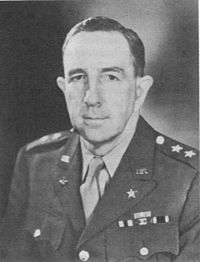Ray Barker
Ray Wehnes Barker (December 10, 1889 – June 28, 1974) was a Major General of the Allied Forces, and served in the European Theater of Operations During World War II. General Barker was a key member of the combined United States-British group, which became known as COSSAC (Chief of Staff to Supreme Allied Commander). This group planned the Battle of Normandy, codenamed "Operation Overlord", also known as D-Day, which liberated Occupied France. He served as the Deputy Chief of Staff of the European Theater from 1943–1944, and Deputy Chief of Staff for Supreme Headquarters Allied Expeditionary Force.
Ray Barker | |
|---|---|
 Ray Barker | |
| Born | December 10, 1889 Elmira, New York |
| Died | June 28, 1974 (aged 84) Fort Bragg, North Carolina |
| Place of burial | |
| Allegiance | |
| Service/ | |
| Years of service | 1910–1946 |
| Rank | |
| Commands held |
|
| Battles/wars |
|
| Other work | Head of The Manlius School, Manlius, New York |
Early and Military Professional Life
Ray Barker was born in Elmira, New York and enlisted in the Army first serving with the 15th Cavalry from 1910 to 1913. He was commissioned as an officer in the Cavalry in 1913, later participating in the Punitive Expedition into Mexico (Pancho Villa Expedition) from 1916 to 1917. Thereafter, he transferred to the field artillery and accompanied the 13th Field Artillery to France in World War I. He served in the Marne-Vesle and Meuse-Argonne offensives.
In 1928, he graduated from the Command and General Staff School, and in 1940 from the Army War College.
He was the commanding officer of 31st Field Artillery from June 1940 to April 1941. He commanded the 30th Field Artillery from June 1941 until April 1942. After promotion to brigadier general in July 1942, he later became the Deputy Chief of Staff of the European Theater from 1943–1944, and Deputy Chief of Staff for Supreme Headquarters Allied Expeditionary Force. He was promoted to major general in June 1943. In January 1946 he assumed command of the 78th Infantry Division, headquartered in Berlin, succeeding Major General Edwin P. Parker Jr.. He was commander supervising demilitarization of Germany until the deactivation of the 78th in May 1946 (see: commandants of Berlin American Zone). Major General Ray Baker retired from the military in February 1947.[1]
Decorations
His decorations included the Distinguished Service Medal, Legion of Merit and the Bronze Star Medal or Soldier's Medal.
| Army Distinguished Service Medal | |
| Legion of Merit | |
| Soldier's Medal | |
| Bronze Star Medal | |
| Mexican Service Medal | |
| World War I Victory Medal with four battle clasps | |
| Army of Occupation of Germany Medal | |
| American Defense Service Medal | |
| American Campaign Medal | |
| European-African-Middle Eastern Campaign Medal with four service stars | |
| World War II Victory Medal | |
| Army of Occupation Medal |
Negotiations
In 1945, Major General Ray Barker, the SHAEF Assistant Chief of Staff for Personnel (G-1), was the officer responsible for recovery of Allied POWs.
Between 16 and 22 May 1945, Major General Ray W. Barker, and Lieutenant General K.D. Golubev, representing the Soviet repatriation authority, met at Halle, Germany. The general principles agreed to at Yalta provided the framework for the Halle discussions. With respect to the return of western Allied prisoners, the Halle meeting centered on working out the administrative details for the prompt release and return to SHAEF control of all British and American POWs, using available air or motor transport.
Despite the seemingly straightforward nature of this problem, the Soviets prolonged the negotiations, citing practical and administrative obstacles and tying rapid release of American, British, and other Allied POWs to repatriation of all Soviet prisoners and displaced persons in the West, many of whom did not want to return to the Soviet Union. The conferees finally reached agreement on a plan in the early morning hours of 22 May. They finalized delivery and reception points for each side, transportation plans, daily transit capacities of each of the reception-delivery points, and other details. Barker and Golubev signed the Halle Agreement on 22 May 1945. However, most Americans liberated by the Soviets in central Germany and along the Baltic coast, had been exchanged by local arrangement prior to implementation of the Halle Agreement on 23 May.
Post Army Career and The Manlius School
Ray Barker served as the headmaster at The Manlius School, an independent, non-sectarian, college-preparatory military school for boys in the town of Manlius in Central New York. Barker served from 1946 until 1960. During this tenure, he accompanied retired general Lucius Clay on a trip to Berlin, Germany, for the dedication of that city's Liberty Bell on October 24, 1950.[2]
Further reading
- Harrison, Gordon (1951). Cross Channel Attack. The U.S. Army in World War II: European Theater of Operations. United States Army Center of Military History. CMH Pub 7-4.
Primary sources
- "BARKER, RAY W.: Papers, 1942-46. DWIGHT D. EISENHOWER LIBRARY: ABILENE, KANSAS. 3-31-75" (PDF). Archived from the original (PDF) on November 1, 2004. Retrieved September 24, 2013.
- 1992-1996 Findings Of The WWII Working Group
- Durston, Harry C., History of The Manlius School. 1966
- Arlington Cemetery Record
External links
| Wikimedia Commons has media related to Ray Barker. |
- Papers of Ray W. Barker, Dwight D. Eisenhower Presidential Library
- Arlington National Cemetery Gravestone Photo, section 30, site 610:[3]
References
- Russell C. Jacobs, June 2007, Arlington National Cemetery Website, accessed May 10, 2009
- Bennett, Lowell. Freedom Bell Tolls Message of Hope and Faith, in Information Bulletin, High Commission of Germany, November 1950.
- http://www.arlingtoncemetery.net/rwbarker.htm